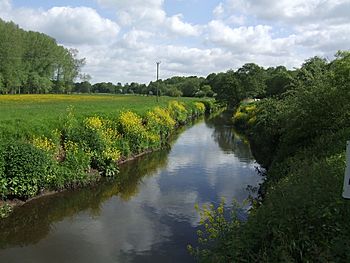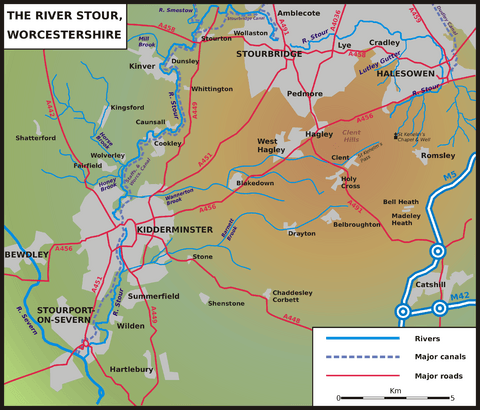River Stour, Worcestershire facts for kids
Quick facts for kids River Stour |
|
|---|---|

River Stour near Caunsall
|
|
| Country | England |
| Counties | Worcestershire and Staffordshire |
| Physical characteristics | |
| Main source | Clent Hills, Worcestershire |
| Length | 40 km (25 mi) |
The River Stour is a river in England. It flows through the counties of Worcestershire, the West Midlands, and Staffordshire. The Stour is a major branch of the River Severn. It is about 40 kilometers (25 miles) long. This river has been very important in the history of the area, especially for its industries.
Contents
What's in a Name? The River Stour's Story
The name Stour is common for rivers in England. It's interesting because rivers with this name are not found in Wales. There are even two rivers called Sture in Italy and one called Stoer in Germany.
The way people say "Stour" can be different. For example, the Stour in Kent sounds like "tour." But the Stour in Worcestershire and Suffolk always rhymes with "hour."
Nobody is completely sure where the name "Stour" comes from. Some people think it might mean "large" or "powerful." Others think it could mean "tumult" or "commotion," like a noisy battle. One idea is that it comes from an old word for "blowing dust."
Some experts believe the name might come from an old European river name. Another idea is that it comes from dŵr, the Welsh word for water. It's possible that each River Stour got its name in a different way. So, the mystery of the name continues!
Where Does the River Stour Flow?
The River Stour starts in the north of Worcestershire. Its source is in the Clent Hills, near Romsley. As it flows down, it gathers water from many smaller streams from the Clent Hills.
The river first flows northeast, then turns north into the West Midlands at Halesowen. It continues through Halesowen, getting stronger from more Clent streams. Then it turns west through the southern part of the Black Country, staying in the Metropolitan Borough of Dudley.
It passes through Cradley and Lye. Then it flows between Stourbridge (which is named after the river) and Amblecote. This area was once famous for making glass. The river flows through old industrial areas, often hidden. For a few kilometers, the Stourbridge Canal runs alongside it. The Stour then leaves the city area through Wollaston, flowing downhill to Prestwood.
The Stour enters Staffordshire at Prestwood and turns south. From here, the Staffordshire and Worcestershire Canal follows it closely. The canal even crosses over the river on a stone bridge! Soon after, the Stour is joined by the Smestow Brook, a big stream that drains the area north of Wolverhampton. The Stour then flows south to Stourton and loops around the village of Kinver. After Kinver, it flows back into Worcestershire.
Passing through Caunsall, Cookley, and Wolverley, the Stour is joined by the Horse Brook and the Honey Brook. Further south, the Wannerton Brook adds water from the Blakedown area. The Stour then flows right through the middle of Kidderminster. Here, it goes under the canal for a short distance before appearing again. At the south end of Kidderminster, the Barnett Brook joins the Stour. This brook starts in the Clent Hills and creates many pools. Finally, the Stour reaches Stourport and joins the mighty River Severn.
The River Stour's Landscape
The Stour begins in the Clent Hills, which are made of a type of rock called new red sandstone. This sandstone traps the river on a high, flat area called a plateau. The river's path is mostly over this same sandstone and some gravel. It takes a winding route to get off the plateau and reach the River Severn valley.
The Stour carries a lot of sand, especially after it rains. This shows you what kind of ground it flows over.
Wildlife Returning to the Stour
The Stour was once a great place for trout. But sadly, industries along its banks released chemicals into the water, making it very polluted.
Good news! In the last few decades, this pollution stopped. The river has been cleaned up, and wildlife is coming back! Now, you can see beautiful kingfishers and grey herons along the river. There have even been reports of salmon and trout returning as far upstream as Stourbridge. It's a great example of how cleaning up our rivers can help nature thrive.
A Look at the Stour's Past
For a short part of its journey west of Stourbridge, the Stour used to mark the border between the old counties of Staffordshire and Worcestershire. It also formed part of the boundary for an area of Shropshire that included Halesowen.
Industry Along the Stour
Mills were very important in the past, and the Stour had enough power to run them. Some of the earliest mills were mentioned in the 12th century at Cradley and Kinver.
From the Middle Ages, the lower Stour was key for early industries. Its mills helped make cloth thicker in places like Worcester, Kidderminster, and Kinver. Later, in the 1600s, many ironworks appeared. These places turned raw iron into useful bars and rods for making nails in the Black Country. Blade mills, often on smaller streams, sharpened tools like scythes.
Many mills on the Stour were used for making iron. They changed uses as needed. For example, cloth mills sometimes became iron mills. Famous iron-making families like the Foleys and Knights worked along the Stour. Even though iron production continued into the 1800s, the valley's industry was later overshadowed by bigger factories in the Black Country.
In the 1660s, people tried to make the River Stour itself navigable for boats. But this plan didn't work out because they ran out of money. It was also very difficult to navigate due to all the bends in the river.
A short section of the Stour at Wilden was made navigable. It had a lock that connected the Staffordshire and Worcestershire Canal to the river. This allowed canal boats to use the Stour to deliver wood and later coal and iron to the Wilden Works. This link was closed around 1950.
The Staffordshire and Worcestershire Canal was built between 1770 and 1772. It runs alongside the Stour, cutting across its many bends. From Stourton Junction, the Stourbridge Canal led to Stourbridge. Other branches of the canal went to coal mines and linked to the Dudley Canal. These canals were built in the late 1700s, creating a network of waterways that ran next to the river.
Later Industries and the Stour
Kidderminster became famous for carpet-making around 1785. The Stour became even more important as this industry grew. The river powered the machines that made and processed carpets. It also carried away waste water, especially when dyed cloth was washed. The carpet makers in Kidderminster fought hard to protect the Stour's water flow. They didn't want water taken from the Smestow Brook, which could have helped cities like Wolverhampton.
The impressive Stambermill Viaduct is a bridge that carries a railway line over the Stour between Stourbridge and Lye. Today, only goods trains use this line.
Branches of the Stour: Tributaries
The main streams that flow into the River Stour are called tributaries. Here are some of them, listed as you travel upstream from where the Stour meets the River Severn:
- The Barnett Brook or Belne Brook: This stream joins from the left. It starts in the Clent Hills and flows through places like Belbroughton and Drayton. In Kidderminster, it joins the Hoo Brook.
- The Wannerton Brook: This stream joins the Stour near Wolverley. It has three main feeder streams that come together in Blakedown. Two of these streams also start in the Clent Hills.
- The Honey Brook: This stream joins from the right, near Wolverley.
- The Horse Brook: This stream also joins from the right. It brings water from areas like Shatterford and Kingsford.
- The Mill Brook: This stream enters from the right near Kinver. It drains an area north of Kinver.
- The River Smestow: This is the Stour's biggest tributary. It starts north of Wolverhampton and flows past Wombourne before joining the Stour at Prestwood.
- The Lutley Gutter (also called the Pudding Brook): This stream joins from the left at Cradley. It was very important for the industrial history of the town.
Towns and Villages Along the Stour
Here are the main towns and villages along the River Stour, starting from where it joins the River Severn and moving upstream:
In Worcestershire
- Stourport-on-Severn: A town known for its canal port and as a tourist spot, where the Stour meets the Severn.
- Kidderminster: A busy center for industry and business.
- Wolverley: A village that includes the nearby villages of Cookley and Caunsall.
In Staffordshire
- Kinver: Once an important industrial village, now mostly a place where people live and visit.
- Stourton and Prestwood: Villages along the river's path.
In Dudley Metropolitan Borough (West Midlands)
- Stourbridge: Famous for its glass industry, with suburbs like Wollaston and Amblecote.
- Lye: Once a center for heavy industry, now known for its Indian restaurants.
- Cradley: Known in the past for making chains.
- Halesowen: Used to be known for making nails, but now it's mostly a residential and business area.
Back in Worcestershire
- Romsley: This is where the River Stour begins, from a spring outside the main village.
Images for kids
-
St Kenelm's Spring in Romsley, Worcestershire on the Clent Hills, the source of the Stour.
-
A sandstone aqueduct carrying the Staffordshire and Worcestershire Canal over the Stour.
-
The River Stour joining the River Severn in Stourport-on-Severn.







